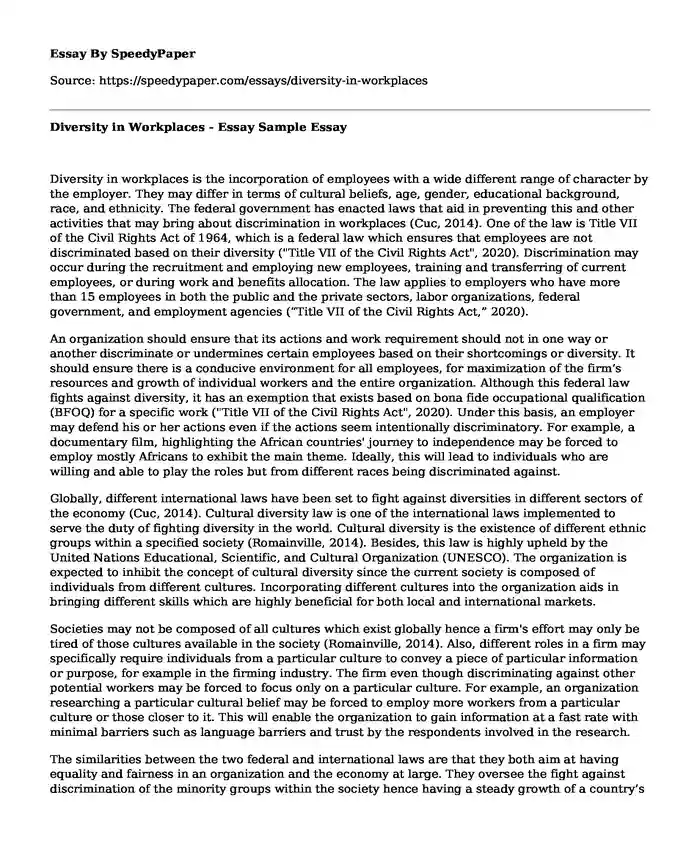
| Type of paper: | Essay |
| Categories: | Employment Society Diversity |
| Pages: | 3 |
| Wordcount: | 733 words |
Diversity in workplaces is the incorporation of employees with a wide different range of character by the employer. They may differ in terms of cultural beliefs, age, gender, educational background, race, and ethnicity. The federal government has enacted laws that aid in preventing this and other activities that may bring about discrimination in workplaces (Cuc, 2014). One of the law is Title VII of the Civil Rights Act of 1964, which is a federal law which ensures that employees are not discriminated based on their diversity ("Title VII of the Civil Rights Act", 2020). Discrimination may occur during the recruitment and employing new employees, training and transferring of current employees, or during work and benefits allocation. The law applies to employers who have more than 15 employees in both the public and the private sectors, labor organizations, federal government, and employment agencies (“Title VII of the Civil Rights Act,” 2020).
An organization should ensure that its actions and work requirement should not in one way or another discriminate or undermines certain employees based on their shortcomings or diversity. It should ensure there is a conducive environment for all employees, for maximization of the firm’s resources and growth of individual workers and the entire organization. Although this federal law fights against diversity, it has an exemption that exists based on bona fide occupational qualification (BFOQ) for a specific work ("Title VII of the Civil Rights Act", 2020). Under this basis, an employer may defend his or her actions even if the actions seem intentionally discriminatory. For example, a documentary film, highlighting the African countries' journey to independence may be forced to employ mostly Africans to exhibit the main theme. Ideally, this will lead to individuals who are willing and able to play the roles but from different races being discriminated against.
Globally, different international laws have been set to fight against diversities in different sectors of the economy (Cuc, 2014). Cultural diversity law is one of the international laws implemented to serve the duty of fighting diversity in the world. Cultural diversity is the existence of different ethnic groups within a specified society (Romainville, 2014). Besides, this law is highly upheld by the United Nations Educational, Scientific, and Cultural Organization (UNESCO). The organization is expected to inhibit the concept of cultural diversity since the current society is composed of individuals from different cultures. Incorporating different cultures into the organization aids in bringing different skills which are highly beneficial for both local and international markets.
Societies may not be composed of all cultures which exist globally hence a firm's effort may only be tired of those cultures available in the society (Romainville, 2014). Also, different roles in a firm may specifically require individuals from a particular culture to convey a piece of particular information or purpose, for example in the firming industry. The firm even though discriminating against other potential workers may be forced to focus only on a particular culture. For example, an organization researching a particular cultural belief may be forced to employ more workers from a particular culture or those closer to it. This will enable the organization to gain information at a fast rate with minimal barriers such as language barriers and trust by the respondents involved in the research.
The similarities between the two federal and international laws are that they both aim at having equality and fairness in an organization and the economy at large. They oversee the fight against discrimination of the minority groups within the society hence having a steady growth of a country’s and overall global standard of living of people. The main difference is that the federal law only applies to the United States boundaries while international law is a worldwide law applying to multiple nations under the United Nations umbrella. The cultural diversity law mainly focuses on the incorporation of the different cultures in a society based on cultural believes and not their numerous diversity like age, sex, race, and educational background as compared to federal law which embraces a wide variety of diversity among individuals.
References
Cuc, M. (2014). Educational Policies to Promote Cultural Diversity. Procedia - Social And Behavioral Sciences, 127, 53-57. doi: 10.1016/j.sbspro.2014.03.211
Romainville, C. (2014). Cultural diversity as a multilevel and multifaceted legal notion operating in the law on cultural policies. International Journal of Cultural Policy, 22(2), 273-290. doi: 10.1080/10286632.2014.959510
Title VII of the Civil Rights Act. (2020). Retrieved 23 September 2020, from https://www.justia.com/employment/employment-discrimination/title-vii/
Cite this page
Diversity in Workplaces - Essay Sample. (2023, Dec 16). Retrieved from https://speedypaper.net/essays/diversity-in-workplaces
Request Removal
If you are the original author of this essay and no longer wish to have it published on the SpeedyPaper website, please click below to request its removal:
- Free Essay on Asian Pacific Americans
- Free Essay on Growing Up as Homosexual
- Depiction of Race and Ethnicity Figure in Media - Essay Example
- Essay Example on Ukraine Geopolitics
- Free Essay on Fashion Items for Ladies
- Why Black Lives Matter? - Argumentative Essay Sample
- Essay Example: How Using Culturally Responsive Pedagogy Aides the Language Learners
Popular categories




